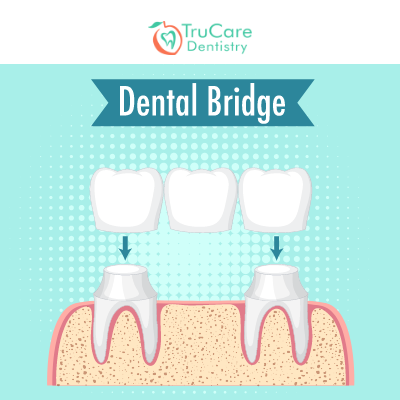Do you wish to avoid getting a dental implant due to the invasive procedure? Why worry? You can opt for a cantilever dental bridge instead.
TruCare team is very experienced for dental bridges Roswell GA. Besides a traditional bridge, you can also opt for a cantilever bridge, implant-supported bridge, or Maryland bridge. In this blog, let’s focus on the pros and cons of cantilever dental bridges.
Yes, besides a traditional bridge, you can also opt for a cantilever bridge, implant-supported bridge, or Maryland bridge. In this blog, let’s focus on the pros and cons of cantilever dental bridges.
The unique structure of a cantilever dental bridge
The dental bridge requires just one adjacent solid tooth next to the extracted or missing tooth. The bridge is cemented on the adjacent tooth.
The cantilever dental bridge appears totally natural. Therefore, dentists often recommend it to patients with a missing front tooth.
The device comprises ceramic, zirconia, all-porcelain, or porcelain-fused-to-metal. You can assume it to last for at least seven years if you follow good oral hygiene.
Installing the dental bridge
A cantilever bridge is aesthetically pleasing because it does not have metal bands. The dental device improves the patient’s smile by covering irregularities. It functions like a natural tooth.
First, your surgeon will take digital dental impressions for the bridge. Then, they will file down the abutment tooth enamel or dentin to make space for the crown over the top. Again, dental impressions are taken for the permanent crown after filing the enamel. A temporary crown is then placed on the tooth until a permanent one arrives from the lab along with the dental bridge.
During the second scheduled visit, the temporary crown is replaced with a permanent one, and the cantilever bridge is placed on the same. The dental device is cemented on the prepared tooth once it is completely adjusted.
The treatment enjoys a good success ratio. Plus, the procedure is reversible. Therefore, you can always consider the option to get the bridge removed if you plan to opt for an impact at a later stage.
Aesthetically pleasing option
A cantilever bridge is aesthetically pleasing because it does not have metal bands. The dental device improves the patient’s smile by covering irregularities. It functions like a natural tooth.
Fewer possibilities of complications
Cantilever bridge placement requires a dentist to file down just one tooth. Only some parts of the enamel are removed. As a result, its natural tooth structure remains intact. Thus, the treatment is conservative but its only recommended for teeth which doesn’t take functional load such as lower or upper anterior teeth.
Cantilever bridges prevent the adjacent teeth from shifting
Loss of a tooth creates a gap, and adjacent teeth might shift into the empty space. Cantilever bridges prevent these teeth from mispositioning and keep them in a normal position. This reduces the chances of decay, gum disease, and dental crowding.
Reduces the chances of developing speech problems
Post dental extraction, the gap between teeth triggers various issues. One of them is a speech problem. Patients even end up spitting a bit while they talk. In addition, they start facing difficulties while pronouncing specific words.
What’s the solution? Fixing the gap with a cantilever bridge can resolve the issue.
Restoring the chewing ability
A gap created due to tooth extraction impacts the individual’s chewing abilities up to a certain extent. Plus, debris gets accumulated in the empty space whenever you eat. But, no worries, a dental bridge can restore your chewing ability as it works like a regular tooth.
Restoring your smile
There is ample research highlighting how losing a natural tooth can impact your smile. Plus, you might end up feeling embarrassed or self-conscious due to the missing tooth, and try smiling without opening your mouth.
A cantilever bridge matches your natural teeth. It not only covers the space but also restores your smile.
Risk factors
There’s always a slight chance of bridge failure. The risk increases if a non-vital tooth is used as an abutment. Most importantly, the bridge has support only on one side. So, chances of debonding from the support or cracking are high. The device may not sustain too much pressure.
Why is a cantilever bridge not ideal with back teeth?
Back teeth are large and apply most pressure while chewing food. The cantilever dental bridge gets support only from one side. Therefore, it might collapse or get damaged if placed in the back. It can replace a lateral incisor or a premolar (middle) at best.
Can individuals suffering from gum disease opt for a dental bridge?
Yes, but dentists will address the infection first before placing the bridge. Patients must have healthy gums and surrounding tissues for the bridge.
Is a dental cantilever bridge a better and cheaper alternative to implants?
Both options are ideal for replacing missing teeth. But an implant costs more. Plus, patients with bone loss or gum issues cannot opt for an implant.
Oral hygiene remains crucial
Yes, food particles and debris can accumulate on and around the bridge due to poor oral hygiene. Placing a dental restoration does not mean you can ignore oral hygiene. Brushing and flossing remain as crucial as before.
Dentists recommend mouthwash, toothpaste, and other cleaning routines to keep the bridge clean.
You definitely don’t want your natural teeth to get decay and gum disease, do you? So, use additional tools recommended by your dentist to clean the dental fixture regularly.
The endnote:
Are you searching for dental implant substitutes? If you are in Roswell (GA), fix an appointment at TruCare Dentistry. Let us evaluate your oral health and recommend the best suitable dental bridge to get your smile and chewing ability back.

